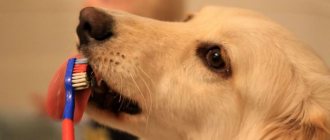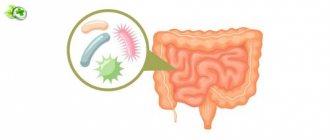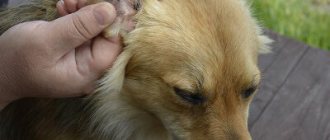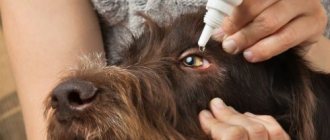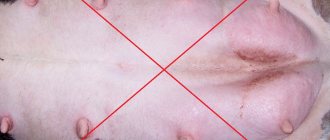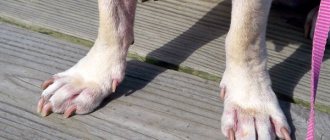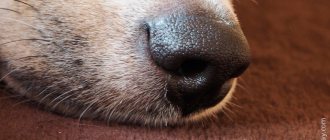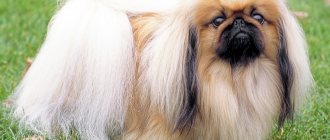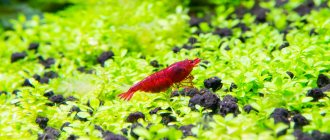Breeders have mixed feelings about toothpaste. Many believe that this is normal pampering and the pet cleans its teeth on its own using bones and hard snacks. Despite natural processes, using even the most ordinary toothpaste will protect your beloved dog from a huge number of diseases.
To fully answer whether toothpaste is needed or not, it is worth understanding this in detail.
Why is toothpaste so necessary?
Toothpaste is a necessary thing for a dog’s oral hygiene.
Toothpaste contains special substances that help better clean plaque from the enamel. If you do not follow the rules of hygiene, then gradually accumulating plaque will begin to transform into stones. Toothpaste for dogs protects against tartar, which gradually leads to the development of dental pathologies in the mouth.
In addition, toothpastes for dogs and puppies perfectly freshen breath and help get rid of harmful bacteria, which allows you to keep your dog’s oral cavity in good condition. The result of regular cleaning will be the good health of your pet.
What is tartar and how to find out about its appearance
During the examination, plaque can be seen at the base of the teeth, which at first has a pale yellow color. The formations are soft and loose. But over time, it mineralizes and hardens, and the color becomes dark brown or almost black.
Tartar forms on those parts of the tooth that do not have direct contact with food or toys: on the front of the teeth or at their very base.
Symptoms
At the initial stage, tartar does not cause much discomfort to the dog. Among the symptoms that may alert the owner are a strong odor from the mouth and a gray coating , actually the stone itself, on the teeth (closer to the gum).
If the problem is not addressed, symptoms may become more severe:
- the dog may refuse to eat food due to discomfort when chewing and grasping food;
- bleeding gums;
- the smell becomes putrid and intense;
- teeth are mobile and may even fall out during feeding.
What does daily oral hygiene do for dogs?
Animals are not able to take care of their oral cavity on their own. After some time, plaque accumulates, and as a result, harmful microbes begin to gradually destroy the teeth.
Losing teeth is a big problem for a dog; it cannot eat normally, and problems arise in the functioning of the digestive tract. As a result, the animal's body ages faster.
Dogs may develop diseases such as caries, periodontal disease, tartar, stomatitis and other oral pathologies.
For the little ones
Today, many people choose decorative dog breeds: Chihuahuas, toy terriers and other kids are very convenient for apartment living. These dogs live quite a long time, about 20 years, but, unfortunately, they are susceptible to diseases of the oral cavity, in particular they suffer from the presence of tartar. To ensure that your pet remains able to eat normally, it is extremely important to start brushing his teeth with special toothpastes from a very young age. Veterinarians say that this procedure should be performed at least once a week, and it is better to reduce the interval to once every three days.
How often should you brush your dog's teeth?
Basically, all dog toothpastes contain safe substances, so they can be used daily if desired. If you can’t brush your teeth every day, then the procedure can be done once every two days.
Attention! Puppies have baby teeth that will gradually be replaced by permanent teeth, so they do not require active care during childhood.
The paste and brush will do an excellent job of cleaning your animal’s teeth.
Visiting a veterinarian-dentist
Regular examination by a veterinarian is important for a pet of any age. If the doctor sees that the patient’s oral cavity is in poor condition, then a visit to the dentist is inevitable.
Is a routine inspection necessary?
A routine examination by a veterinarian is necessary for animals of all ages. It is often combined with vaccination.
The doctor examines the patient, takes his temperature, and also looks into his mouth. If there are any suspicious spots, plaque, or inflammation, the owner and the animal are sent to a specialist. A routine examination by a therapist is carried out annually, for elderly pets and chronically ill animals - 2-3 times a year.
The intervention of a veterinarian-dentist is necessary if the owner cannot cope with the care of the pet’s fangs on his own. This happens when the food is selected incorrectly or when soft food predominates in the diet. A visit to the dentist is necessary if the owner notices:
- bleeding or reddened gums;
- unpleasant odor from the mouth;
- dark spots on the enamel.
The dentist will examine the patient and give recommendations on mouth care. The doctor may prescribe a special medicinal paste or vitamin complexes that will have a positive effect on the animal’s condition.
Professional cleaning
Deep cleaning and removal of dense stones is performed only by a specialist in a veterinary clinic. Anesthesia is rarely used for this procedure; mild sedatives are usually used. They induce shallow sleep throughout the cleaning procedure.
Ultrasonic cleaning is carried out in pet salons. The procedure is performed for 20-90 minutes, depending on the neglect of the patient’s mouth. Ultrasonic waves act on the surface of the enamel without damaging it, but only removing plaque.
The difficulty of ultrasonic cleaning is that the dog cannot eat 8 hours before it is performed. It is recommended to carry out professional cleaning no more than once a year. More frequent use of ultrasound can thin the enamel and cause its destruction.
Inexperienced owners wonder whether they need to brush their dog’s teeth and how to do it at home. Veterinarians recommend examining and cleaning the mouth at least twice a week using special pastes and brushes. Dogs should be taught the process of cleansing from early puppyhood. To avoid oral health problems, you can purchase alternative options for cleaning your teeth.
The article is a recommendation!
How to choose
Before purchasing, it is recommended to study several different options, familiarize yourself with the composition and manufacturer. In addition, you need to pay attention to the following points:
- best before date,
- Is the packaging damaged?
- How tightly does the tube close?
- presence of natural ingredients,
- flavorings used.
Before use, it is recommended to study the paste itself - it should be white, not contain any impurities, and should not foam.
Attention! If there is anything suspicious, you cannot use the product.
Do-it-yourself home cleaning
Owners whose dogs do not tolerate a visit to the clinic are wondering how to clean tartar from their dog’s teeth at home. To remove stone deposits on your own, you usually resort to special means or mechanical procedures.
Our range of cleansers suitable for home use includes:
- sprays. Their advantage is that they are certified and easy to use. It is assumed that after applying the spray the animal will not drink or eat food for 40 minutes. After time, it is necessary to remove the softened plaque with a clean napkin;
- gels. The product prevents the formation of tartar, heals gums, removes plaque, freshens breath;
- liquids and elixirs. A cloth soaked in the medicinal composition is applied to the affected area, after which the plaque is removed;
- toothpaste. Designed for preventive purposes;
- special toys and chewing braids with a cleaning effect.
Important! All of these products are designed for small stone formations.
You can only get rid of large stone growths with a dental scaler or a blunt scalpel. To carry out such a procedure, you need to be completely confident in your abilities and the patience of the dog.
Actions must be calm and careful so as not to harm the pet.
For your information! There are also some folk ways to deal with stones, such as rubbing with lemon juice or a piece of tomato. Their effectiveness is exaggerated; such procedures can only be carried out for prevention.
Tomato puree
To remove already hard plaque, many owners resort to such a well-known method as treating tartar with a tomato (it is obviously crushed into a puree-like mass). The owner’s task is to lubricate each tooth of his pet with this mass every 30 minutes during the day.
Usually, by lunchtime, a cat or dog is trying to hide from its beloved owner in any possible place. If you pass this difficult test to the very end without being bitten, scratched or in a bad mood, then now all that’s left to do is to remove the softened stone from the surface of each tooth with gauze napkins.
The only pity is that it still won’t be possible to remove the stone from under the gum, which means the inflammation won’t go away. In general, the method is good, but very exhausting for everyone and, in the end, not entirely effective.
Spray for removing tartar in dogs
Dentists advise using not only gels, but also sprays to remove dental plaque. Thus, Petzlife anti-tartar spray for dogs is a safe product made from natural ingredients. It is easy to use: you need to lift the dog’s upper lip and apply the substance to the area of the teeth and gums. Do not give the animal food or drink for 30-40 minutes. Experts recommend using this spray twice a day.
Anti-tartar gel for dogs
You can remove tartar in dogs at home using a special gel. For example, Tropiclin contains natural ingredients that destroy pathogenic bacteria in the animal’s mouth, soften tartar and clean plaque. In the evening after feeding, apply 2 drops of gel to the teeth. The dog begins to lick its lips, and the product mixes with saliva and, covering all the teeth, begins its action. During subsequent teeth cleaning, the softened stone is easily removed.
Top brands
In specialized outlets you can find many offers of toothpaste for dogs. However, there are a few of the most famous:
- Dental Fresh,
- Beaphar Dog A Dent,
- Platinum,
- Clini,
- Tropiclean,
- Hartz Dentist's Best Toothpaste.
These are the most popular brands that are of good quality.
There is a large selection of toothpaste in stores
Useful tips
The choice of which paste to use is an individual matter. It is recommended to carefully study the composition to avoid allergic reactions in the animal. You also need to use the substance carefully, monitor the dog’s condition and how he perceives the procedure. The best option is to teach your dog to brush its teeth from early childhood.
Toothpaste for dogs is an excellent product that helps keep your pet's mouth in perfect order. The choice of substance depends on many parameters that must be taken into account in order not to cause discomfort to the pet.
How at home?
To ensure a successful brushing of your pet's teeth, you need to make the experience enjoyable for both of you. It is worth praising the animal during all manipulations with its mouth and rewarding it upon completion. It should be taught from childhood, from 2 months . Of course, the puppy’s baby teeth do not yet need to be cleaned, but by accustoming him at this stage to the fact that the owner is constantly doing something with his mouth, you will avoid problems in the future.
Puppy
The animal is unlikely to be delighted with manipulations with its mouth, so you should not immediately reach into it with a toothbrush. Let's begin a gradual training on how to properly start brushing a dog's teeth by replacing the brush with the owner's fingers !
How to relax your dog before brushing his teeth:
- Prepare delicious meat broth.
- Wait until your pet is calm and not irritated. It is optimal for the dog to want to play. You should not brush your teeth immediately after eating: your baby may vomit .
- Sit the animal down and, with your fingers dipped in the aromatic broth, spread its mouth. Place your fingers inside.
- Wait until the dog gets used to these strange actions. After this, the fingers are wrapped in a cloth, still soaked in the broth, and light cleansing movements are carried out.
Advice : if you plan to perform at exhibitions in the future, teach your dog the command “Show your teeth!” It is often included in the list of required commands.
When a trusting relationship has been established between you and the animal, you can move on to regular brushing, but still without a toothbrush :
- Wrap your finger in a bandage and apply a special paste to it. Next, rub your teeth with light movements. You don't need to press hard to avoid scratching the enamel.
- It is unlikely that you will be able to clean all your puppy’s teeth at once: this is tiring for him. Perform the manipulation in several stages.
- There is no need to clean the inner surface of the teeth - your pet can do this very well himself, using his tongue.
- Do not skimp on praise, talk kindly to the dog all the time .
Be sure to note if the dog was sitting calmly. But you don’t need to beat an animal, shout at it or restrain it by force: this way you can scare it for the rest of its life. You shouldn’t even invite an assistant to hold a stubborn puppy: the baby will remember that the procedure was carried out by force, and will continue to resist in the future. It’s okay if you don’t succeed the first time: there’s still a lot of time ahead. - After a while, the finger can be replaced with a baby brush, and then with a special brush.
You can use such wonderful dental wipes!
Adult dog
As an adult, a dog that has been trained since childhood will react to the procedure as if it were something taken for granted. All that remains is to properly clean it.
- Position yourself so that it is comfortable for both you and your pet.
- Apply some paste to your toothbrush. It is better to press it inside the villi so that the dog does not spit out all the paste in the very first seconds of cleaning. Using your index finger, gently lift the dog's lips on one side.
- To open the animal's mouth and brush its lower teeth, gently tilt its head back. The upper jaw is held with the thumb of the free hand.
- The dog's teeth are brushed strictly up and down, otherwise the dirt will simply spread throughout the entire jaw.
- Cleaning begins with large teeth and fangs - this is where all the plaque accumulates. For each such tooth there should be at least 10 movements. The remaining teeth are also cleaned, but this cannot be done every time.
- The brush should be held at an angle of 45 degrees - this way the base of the teeth is better cleaned.
- At the end of the procedure, you can rinse your mouth with chamomile infusion using a syringe. It is good not only for the teeth, but also for the dog’s stomach.
